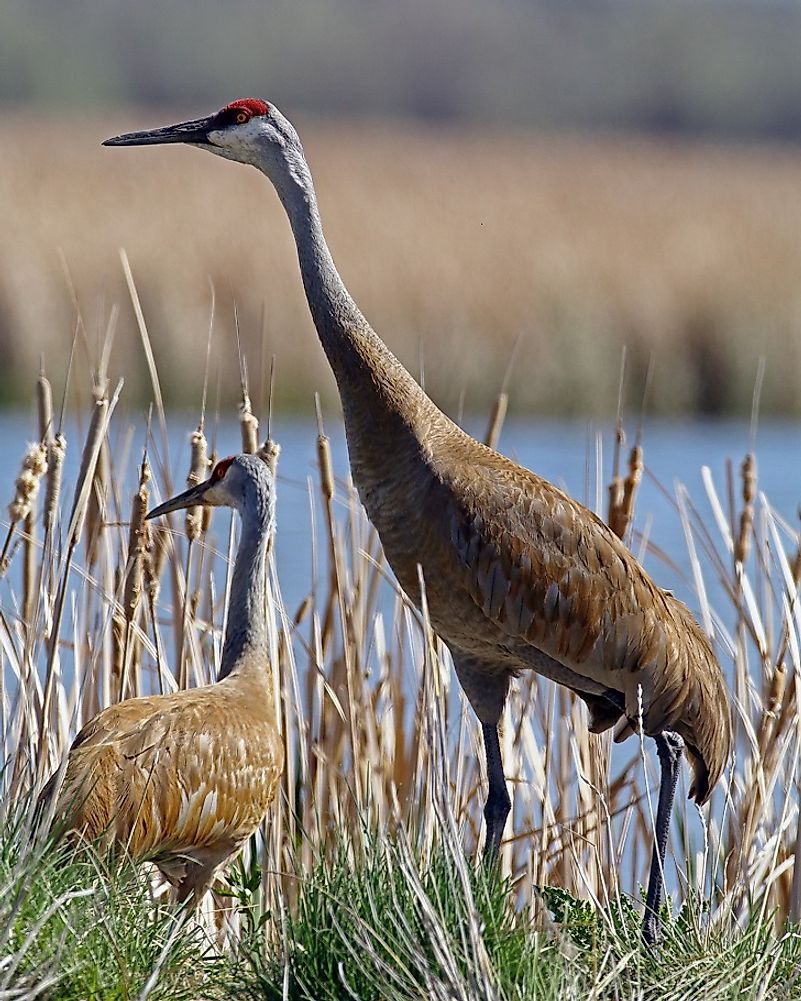Sandhill Crane Facts: Animals of North America

5. Physical Description
The sandhill crane, is a migratory bird, with long, thin legs and neck, and a sturdy, grayish brown beak. Its feathers range from gray to reddish brown in color. The brown hue on the sandhill crane’s feathers can also be attributed to their habit of applying mud to them. On top of the sandhill crane’s head is a dark red patch of skin that distinguishes it from other, similar-looking birds . According to the National Wildlife Federation (NWF), Sandhill crane adults are 3 to 4 feet in height, with a wingspan of over 5 feet. When mature, they weigh from 6.5 to 15 pounds.
4. Diet
As an omnivore, the sandhill crane is an opportunistic feeder, and its diet depends on whatever is readily available in its given habitat. Most times, it eats such plant foods as tubers, berries, and grains, though it will also eat mice, snakes, insects, worms, small birds, lizards, snails, frogs, and crayfish as well, according to National Geographic. The sandhill crane feeds either on land or in shallow marshes where plants grow up out of water, according to research conducted by All About Birds. It gathers food from its surrounding habitat, probes it with its sharp pointed beak, and eats it while still continuing to forage further.
3. Habitat and Range
In the U.S. and Canada, the sandhill crane abounds in large numbers in certain place, as well as to a lesser extent in Cuba, Siberia, and Mexico. According to the National Wildlife Federation, the Sandhill crane lives in freshwater wetlands such as marshes, wet grasslands, and river basins. According to the 2012 International Union for the Conservation of Nature's (IUCN's) Redlist report on threatened species, the Sandhill crane is classified as a species of "Least concern". The International Crane Foundation (ICF) reports the most prominent threats to the sandhill crane are likely to be caused by losses and degradation of wetlands and riverine habitats, occurrences of excessive hunting, and encroachment upon their habitats by human development activities.
2. Behavior
Socially, the sandhill crane typically lives either in pairs or in small groups. They are quite flamboyant as they dance, leap playfully up high in the air, and throw sticks at one another, even when they are not mating. According to the Florida Fish and Wildlife Conservation Commission, when a sandhill crane is fed by humans, it develops aggressive behaviors towards them, and can threaten and even attack children. There have been cases where sandhill cranes have broken glasses after seeing their reflection, and thereby becoming territorial. According to the International Crane Foundation, their voices are characterized by loud rattles with diverse intonations.They use them to keep in touch with each other, reinforcing bonds between males and females. These vocalizations can also be used to warn of dangers from such natural predators as bobcats, raccoons, coyotes, wolves, crows, ravens, eagles and owls.
1. Reproduction
Sexual maturity is reached at two years of age by the sandhill crane, according to the National Wildlife Federation. A male and female pair will mate monogamously for life. Mating partners are chosen based on the dancing displays the exhibit. The dance is characterized stretching and flapping of wings, pumping their heads, bowing, and leaping in the air. When mating, pairs produce a synchronized unison call song, performed while throwing their heads back. After mating, the female lays two eggs which take around a month to hatch, though often only one chick may survive.The hatched chick(s) take two months to become independent, and can then begin migrating with parents. A sandhill crane has an average lifespan of around 20 years, according to National Geographic.











